ST. LOUIS — Watching TV on Election Day is like listening to a sporting event on the radio. Viewers rely on the announcers to tell them what's happening, keep score, and eventually declare a winner.
Here's how they do that.
Election night vocabulary
A race is "too early to call" if there's not enough data in yet, and "too close to call" if margins are so narrow, there will likely need to be a re-count.
You might also hear the term "projected winner." This means the vote count is not complete, but the polls are closed and there is enough information to make a strong prediction. An "apparent winner" means the count is complete in a candidate’s favor, but the final results may hinge on a recount.
A "winner" is clearly ahead and it is almost certain this candidate will win.
An important note: this is all reporting lingo you’ll hear as outcomes are determined, and it is been how Americans have historically accepted election results. However, an official winner is not technically declared until votes are canvassed, or certified, weeks after the election.
Be wary of equating “percent of precincts reporting” to "percent of votes counted." In many cases, it is not a helpful metric. Sometimes, early votes or votes by mail count as one precinct, or the precinct may be reporting some results, but not done counting yet.
KNOW TO VOTE: How long will it take to count ballots on Election Day?
The Associated Press
Many news organizations, including 5 On Your Side, follow reports and projections made by the Associated Press, an international national news service.
The AP relies on thousands of trained race callers around the country watching the counts come in, drawing conclusions only after polls close and voting jurisdictions begin posting tallies.
"Shortly before the polls close, over 4,000 stringers report to county election centers. When the first polls close, they’ll be ready to start phoning in the raw vote as it is reported by the counties. They’ll place their calls to AP election centers around the country, which, due to the pandemic, will be virtual in 2020.
At the centers, a total of more than 800 vote entry clerks will answer those calls, and walk each stringer through a dialogue as they enter the number of precincts reporting and the candidates’ votes into our election night system.
Since many states and counties display their election night results on websites, teams at the election centers also monitor those sites and enter results into the same system. This system tabulates the results and disseminates them in a number of formats to our member news organizations and customers.
The clerks are encouraged to ask questions to ensure accuracy. They’ll ask the stringers whether there are problems in their county, question votes and precincts if results look suspect, and make sure that those working around them ask questions, too. Quality control software checks often interrupt the vote entry with popups, requiring confirmation of numbers if they look inconsistent or are statistically unlikely. Researchers and analysts assess the results as they come in and look for unusual results."
The AP no longer relies on exit polls, which are interviews with voters in person at election locations.
“That approach no longer works for how America votes today. In 1972, when President Richard Nixon was reelected, 95% of voters cast a ballot in person on Election Day. In the 2016 general election, 42.5% of voters chose to vote early, absentee or by mail,” the AP explains.
A winner is declared only after the other candidate has no path to victory.
This year more than ever, they'll have to consider changes that could come as mailed ballots are counted--before making calls.
And at 5 On Your Side, Election Night also means a team of employees reaching collecting vote counts from local election authorities for our local races and ballot issues.

